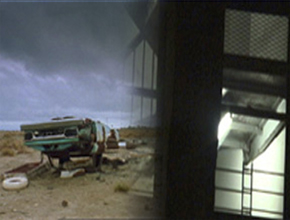Ken Kobland
USA 2003

|
" CinemaxX 3 11.02. 15.30 |
Produktion: Ken Kobland Films, New York
Weltvertrieb: Ken Kobland, 306 Bowery,
New York City 10012, NY, USA
Tel.: (1-212) 674 79 08, Fax: 764 73 66
E-mail: vonkob@mindspring.com
www.kenkoblandfilms.com
Kamera, Produzent: Ken Kobland
Format: DigiBeta, Farbe
Länge: 45 Minuten
Sprache: Englisch, Japanisch, Italienisch,
Schwedisch, Russisch
Buildings and Grounds is a rumination, a series of borrowed 'dialogues' out of an ongoing argument with myself. It meanders, mentally and physically, reflecting on the conditions of being human; on transience, consciousness and desire. It uses landscapes as provocations, as sites of contemplation. And between the landscape and the thought, i.e. between the radical presence of the physical world and the idea, there is, more often than not, a distance, disbelief, or irony. Theoretically I began this film sometime over the winter of 2000/2001. Or at least this was around the time when I began seriously to consider what I was going to make. It had been over a year since I'd finished my last project, (Arise! Walk Dog Eat Donut) and I was hoping in this film to escape from examination of the minutiae of day-to-day existence, with its small drudgeries and litany of disturbed thoughts... I was hoping for something more high-minded, if you will, something about larger ideas and philosophical queries. Specifically I was starting to think about what it means, or will mean, to be human in a world of fantastic, nature-bending technologies which are in the process of decoding everything from disease to desire and recomposing them in a pill formulated in 0s and 1s. How much of an individual, I wondered, can be replaced or modified, chemically or genetically or prosthetically, before the whatever-wasthat- individual is lost. And what would it mean, given the social realities as we know them today, to have effectively conquered all serious disease, or to be able to alter life, or to significantly extend it by scores or hundreds of years.
Ken Kobland, geb. 1946 in New York. Studium von Kunst, Philosophie und Architektur. Filme und Videos seit 1975, im Forum: Miami Man in Landscape Loop (1987), The Communists are Comfortable (1987), Flaubert Dreams of Travel... (1987), Berlin Tourist Journal (1989), Arise! Walk Dog Eat Donut (2000).